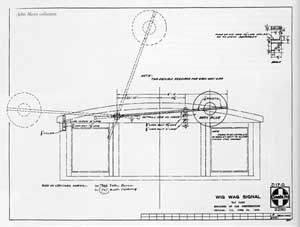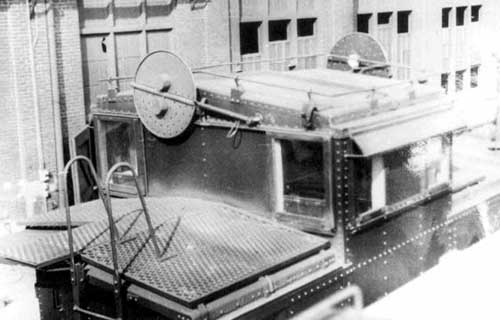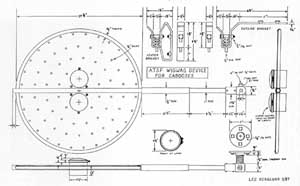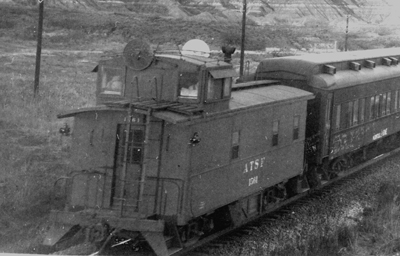|
Wig Wag Highball Signals Updated 8-15-10
Prior to the installation of radios on Santa Fe freights, a visible wig wag signal was installed in the cupola of many ATSF waycars (cabooses). The first signals were the smaller of two styles (18" dia.). The Santa Fe drawing below is dated June 23, 1926. The drawing above shows what it would have looked like from the long end of the car. The second wig wag was a mirror image on the opposite side of the cupola so that both were operated from the same seat of the cupola. When the smaller ones were introduced, they were painted like a bull's eye with dark blue surround and light (white or yellow) center with single light in the middle. By 1943, at least one additional paint scheme appeared for these, a solid color, possibly orange. A light was centered in the middle for nighttime vision. Click here for a photo that includes one of these wig wags. (another) (another)
A second and larger style wig wag came in the mid 30s. John Moore has dated photos showing them in use in 1933. It was 29-3/4" in diameter and was a perforated disk to lighten the weight and reduce wind resistance. The entire disk was painted reefer orange or yellow and had a red and a white light in the middle that would be pointed toward the engine. On the inside of the cupola was a heavily counterbalanced handle to allow the conductor to swing the signal. These signals were mounted on the right side of the cupola as you faced it, whether from the long or short end. Lee Burglund drew plans from one of these in 1987, as published in Caboose Cars of the Santa Fe Railway by Frank Ellington. There is an important design note for modelers. The light(s) in the center of the wig wags pointed toward the locomotive, therefore toward the cupola. The side of the housing which pointed away from the locomotive, therefore away from the cupola, was the same color as the wigwag. Pay close attention to photos with this in mind. Division Point, among others, has mistakenly painted these as if the lights shone to the rear, which would have been meaningless as a train signal.
Andy Sperandeo states that they should be painted "same yellow-orange used on refrigerator cars. I'd recommend Polly Scale MEC Harvest Gold. "
Radios began to arrive around 1950 and the wig wags were slowly phased out as more radio's were installed. Some did remain on cabooses until the late 60s. Art Gibson photographed one in 1967 at Wichita, waiting to go to the Orient Shop for conversion to Ce-1. Frank Ellington has supplied some interesting information from official papers in his files. One was about obtaining parts for the light(s) in the middle of the signals. The older signals required 4-1/4" lights while the newer one had 4" "searchette spot lights." It seems that they would never have the right parts at the right place. A message, 6/26/50, states that on 2100-2200 series cabooses, "highballers extend out from center of car 6'5," which can be increased to 7'1" by moving the bushing (pivot) 8" toward side of cupola or 32" from center line instead of 24." This would locate the bushing same as last 200 cars built, permitting same to be seen better than the small discs without lamps - as 88 cars 2102-2200." An examination of photographs shows that the exact pivot point of the signals was not always the same. Care was taken to insure that the wig wag did not block the view from the cupola window. It is clear from the messages that the older style small wig wags were still in use in the early 1950s. A message dated May 20, 1952, states, "radio seems to meet our needs, wigwag unnecessary -- hold wig wag in stock for other applications." Nine days later, a message gave permission for wig wags to be removed from Valley Division cars. However, a 3/24/53 message states, "Mr. Buchanan takes exception, 'We feel wig wag should be retained on Pecos Div. until all engines are radio-equipped. Until that Div. is fully dieselized, we will have a number of steam engines in use.'" A memo dated 6/10/53 said, "Herewith form 1575-A in amount of $500.00 covering the cost of removing wig wags from 100 cars series 500-599, 2216-2300, and 2113-2197." However, not all cars lost their signals. John Thompson had an email discussion with former Cajon conductor Don Sheets concerning the wig wag signals. Sheets replied, "This may surprise you but we never used the wig-wags you mentioned. There were about 25 freight pools in the valley, i.e., SB to LA-SD, and about 16 to 18 on the hill. I think that there were only 6 or 8 cabooses equipped with the paddles and they were not maintained with battery powered center lights, which made them useless at night." "We never had any outstanding instructions on how to use them but it would be safe to say that if they were not used when required, it meant for the engr. to stop the train, and when used it was a hiball that the caboose had cleared a secondary track such as a yard or siding or that the rear end crew was safely on board." "As far as I know the wig wags were capable of only one motion, back and forth in a half circle over the top of the cupola. Places where the wig wags were used, radios would certainly have rendered them obsolete." "On the LA Div. and I would believe elsewhere, a white flag by day and a trainman's lantern by night was waved out the cupola window or from the caboose steps that the crew was on or the train was on the main. If no hiball, that meant stop the train." John Moore reports, "I
asked a yardmaster back in 1973 for an answer (about how the signals were used).
He had been a brakeman and used the signals. His response was there were two signals
which were given with the wig-wag. Back and forth was HIGHBALL. Straight up was
STOP. For night time operation there were two lights which could be turned on.
A red light which was used with the stop signal and a clear (white) light was
used with the highball signal." Models: Pecos River Brass once made HO versions of the larger wig wag. Those have since been sold out. The Intermountain/Centralia Car Shops Santa Fe caboose kits released in 2009 include these and they are an option for ready to run cars as well. Resources: For a lot more information and some more complete info click here and here. Caboose Cars of the Santa Fe Railway, by Frank M. Ellington: The Warbonnet, 1/99. Mark Wilkouski and John Moore. MR Workshop, by Andy Sperandeo, Model Railroader, September, 1991. p. 118-119. On the web: look at Jack Delano photos (1943) from the Library of Congress collection:
|













